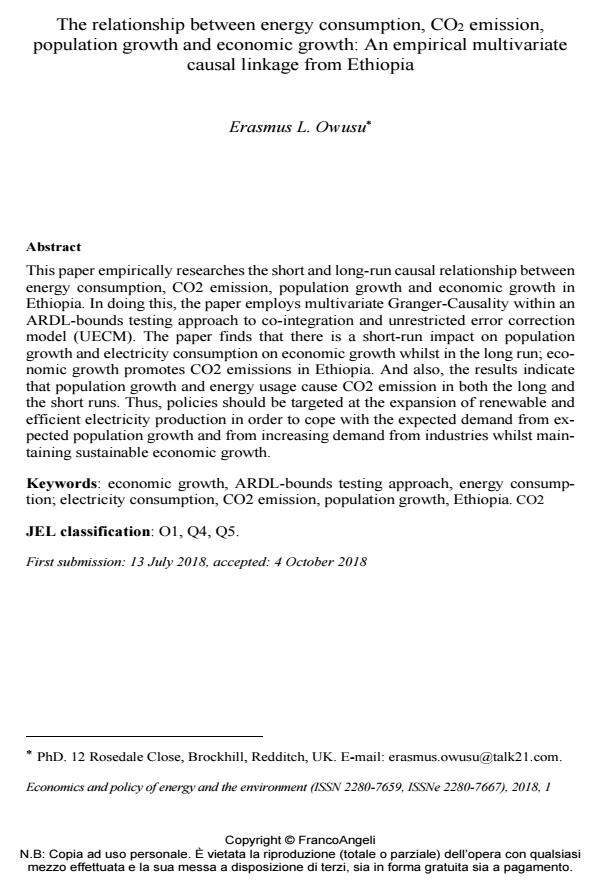The relationship between energy consumption, CO2 emission, population growth and economic growth: An empirical multivariate causal linkage from Ethiopia
Journal title ECONOMICS AND POLICY OF ENERGY AND THE ENVIRONMENT
Author/s Erasmus L. Owusu
Publishing Year 2019 Issue 2018/1
Language Italian Pages 15 P. 225-239 File size 221 KB
DOI 10.3280/EFE2018-001010
DOI is like a bar code for intellectual property: to have more infomation
click here
Below, you can see the article first page
If you want to buy this article in PDF format, you can do it, following the instructions to buy download credits

FrancoAngeli is member of Publishers International Linking Association, Inc (PILA), a not-for-profit association which run the CrossRef service enabling links to and from online scholarly content.
This paper empirically researches the short and long-run causal relationship be-tween energy consumption, CO2 emission, population growth and economic growth in Ethiopia. In doing this, the paper employs multivariate Granger-Causality within an ARDL-bounds testing approach to co-integration and unre-stricted error correction model (UECM). The paper finds that there is a short-run impact on population growth and electricity consumption on economic growth whilst in the long run; economic growth promotes CO2 emissions in Ethiopia. And also, the results indicate that population growth and energy usage cause CO2 emis-sion in both the long and the short runs. Thus, policies should be targeted at the expansion of renewable and efficient electricity production in order to cope with the expected demand from expected population growth and from increasing de-mand from industries whilst maintaining sustainable economic growth.
Keywords: Economic growth, ARDL-bounds testing approach, energy consump-tion; electricity consumption, CO2 emission, population growth, Ethiopia. CO2
Jel codes: O1, Q4, Q5.
- IV INTERNATIONAL SCIENTIFIC AND TECHNICAL CONFERENCE “ACTUAL ISSUES OF POWER SUPPLY SYSTEMS”: ICAIPSS2024 Jiyengu’l Erejepova, Umidbek Abdalov, Sevinchbek Egamov, Sukhrob Davlatov, Shakhinya Igamova, pp.030023 (DOI:10.1063/5.0306549)
Erasmus L. Owusu, The relationship between energy consumption, CO2 emission, population growth and economic growth: An empirical multivariate causal linkage from Ethiopia in "ECONOMICS AND POLICY OF ENERGY AND THE ENVIRONMENT" 1/2018, pp 225-239, DOI: 10.3280/EFE2018-001010